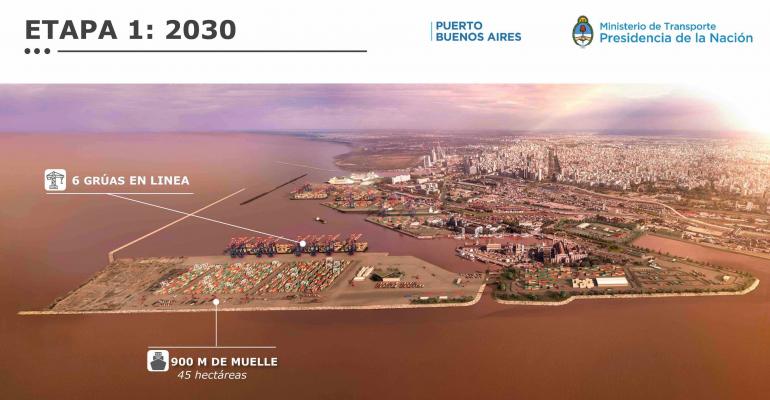Transport Minister Guillermo Dietrich and General Ports Administration controller Gonzalo Mórtola presented the plan today. The bidding process is to begin on Monday.
Flexible design, intermodal integration
The modernization will renew the port with a flexible design, capable of adapting to the needs of the next 50 years in a more competitive manner. Environmental and quality standards are taken into account.
Unifying the end of current port terminal concession contracts to May 2020 will facilitate the modernization, which will be integrated with other initiatives like the Paseo del Bajo, a major roadway project to connect the north and south of Buenos Aires.
$760m private/$300m public investment in first decade
The concession contract envisions that during the first 10 years, the private company will invest $760m in works, while the state will kick in $300m.
Specifications will be available here starting Monday, and interested parties can submit queries and suggestions to [email protected]. The formal tender is scheduled to be launched early next year.
'Compared to other countries in the region, Argentina is behind in foreign trade development. Our cargo volumes fell in the last 10 years while those in the neighboring ports in Brazil and Uruguay grew,' Dietrich said. 'We are reversing that trend, with a federal port that's moving from a deficit to a surplus, which has greatly reduced the costs of exports and imports and has enabled large investments in landfill in the river to add land.
'This project is one more step in that direction,' he continued. 'For the country to grow and develop, we must expand trade with the world, and infrastructure will fuel that growth. That the reason for this megaproject, which we have been developing since the beginning of the port's current management and which is complemented with the Paseo del Bajo, with new rail access and with a future cruise terminal.'
Infill works already begun
From a cargo perspective, the Port of Buenos Aires will go from having a capacity of 1.4m TEUs in 2020 to 2.7m TEUs in 2030. In the next 10 years a large container facility will be developed. The infill works to be able to build it have already started, with 10 hectares already reclaimed from a total of 45 scheduled by 2030.
Mórtola called it a 'great day for the port that belongs to all Argentines.' He added: 'Ports have a very important role in the economies of our countries and this project is fundamental for the development of Argentina and its regional economies, since it is directly linked to the integration of foreign trade in the short, medium and long term.'
Single port access, reduced environmental impact
The plan includes improvements such as a single port access that will decongest traffic in the port area. Additionally, the uninterrupted circulation will reduce environmental and noise pollution and will separate heavy traffic from light traffic.
Establishing a single customs verification zone will lower costs, add efficiency and speed operations. In addition, the total capacity of the port will be increased and connected to the rail system. To guarantee greater transparency, maximum rates will be established to avoid cost overruns and billing surcharges.
Larger ships
The separation of cargo and cruise activity will increase the efficiency and safety of both operations, providing greater comfort and service to passengers. Larger ships will also be facilitated.
Copyright © 2024. All rights reserved. Seatrade, a trading name of Informa Markets (UK) Limited. Add Seatrade Cruise News to your Google News feed.


